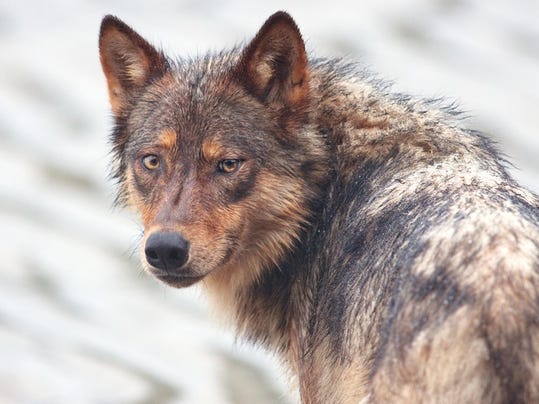YAKIMA, Wash. – Like hunters, David Moskowitz spends a great deal of time in blinds. Moskowitz, though, is hunting knowledge — and the photographs to illustrate it.
The fact that he does much of it in close proximity to wolves — the subjects of his book, “Wolves in the Land of Salmon” (2013, Timber Press) — may be spine-chilling for those who have not had that experience.
But not for Moskowitz. “A lot of people ask me, ‘Are you scared for your safety?’” says Moskowitz, 37, who lives in Washington’s Methow Valley not too far from the home range of Washington’s first verified resident wolves, the Lookout Pack. Actually, with wolves in particular, objectively they’re the least hazardous large carnivore in North America, for humans,” he said. “There’s less issues with them than with mountain lions, black bears, grizzly bears or even domestic dogs. And while there’s a perceived sense of fear there for many people,” he said, “objectively there’s not a whole lot to be concerned about when you’re working in landscapes with wolves.”
Which is precisely what Moskowitz did in his research for the book, with his field work dating him from the Wallowas in northeast Oregon to the Northern Rockies in Montana and southern British Columbia and even to Vancouver Island and the Great Bear Rain Forest on Canada’s Pacific Coast.
An expert tracker and tracking trainer certified through the international Cybertracker Conservation, Moskowitz spent months trailing wolves in order to observe them in their wild environs. He studied pack dynamics, watching pups eagerly welcoming pack members back from a day on the hunt while saving their most enthusiastic, tail-wagging response for their mother.
But his research process wasn’t confined to the animals themselves, but also to the political maelstrom that has surrounded their reintroduction in the northwestern United States. “The whole goal of that book for me was to provide an engaging way to bring people into thinking about different ecological and conservation concepts,” said Moskowitz. “In regards to the many conservation issues out there, (with) any that are tied up in wolves there’s so much rhetoric out there and everybody’s got an opinion about it. I wanted to provide a resource that was accurate, engaging, educational and also not biased.”
To achieve the latter, he said, he tried to “explore some of the things people have said about wolves in the Northwest on both ends of the spectrum — from the far right wing that claims wolves are an introduced species that doesn’t belong in the ecosystem, to the other end, to organizations like Defenders of Wildlife and some others, some of whom make statements that are kind of hard to substantiate.”
Some opponents of wolves’ reintroduction into the Northern Rockies might immediately peg Moskowitz as a wolf advocate, and from a biological perspective — considering the wolf’s role in the ecosystem as a predator species that helps keep the populations of its prey species in check — those people would be right.
But if you spend much talking to him or reading his book, it becomes evident Moskowitz doesn’t perceive wolves as some kind of benign, mythical creature carefully culling the weak and diseased from the food chain, a la Farley Mowat’s fascinating but somewhat idealized “Never Cry Wolf.”
“Just because it’s highly unlikely that they’ll be aggressive towards me, that doesn’t mean they can’t be,” Moskowitz said. “Whenever I’m working around wolves, I carry bear spray and I treat them like the creature that they are — which is something that evolved to kill mammals larger than us and do it efficiently. So you have to be thoughtful and pragmatic about (being around wolves).”
Still, Moskowitz’s calm response to wolves’ proximity during his research surprised Darcy Ottey, who co-wrote a chapter on the book about cultural acceptance of wolves. Ottey, whose background is in anthropology and sociology, was with Moskowitz during a research trip on Vancouver Island when a wolf approached their blind. “I grew up with stories of werewolves and images of wolves as this really scary being,” Ottey said. “The only other time I’d seen wolves was in Yellowstone National Park, and that’s a park with a park-like feel, which makes everything feel a little bit tamer. This was by far the closest wolf experience I’d had. It just got closer and closer (to the blind). I was thinking, wow, how close it going to get?”
Moskowitz, who recognized the wolf’s actions as being born purely of curiosity, wasn’t at all concerned. “I construct these (blinds) so they kind of blend into the landscape,” he said. “He approached, clearly curious, but there was nothing about his body language that said it was aggressive. It circled us until it got to when it picked up our scent and knew it was human-related, and then it just went off. And Darcy was like, why was I not at all concerned?”
Moskowitz was less concerned than fascinated, something he also clearly is about his next project this summer, when he’ll be joining three other “conservation adventurers” in following the 1,200-mile overland journey taken last year by a collared Oregon wolf that became known as Wolf OR-7.
The young male wolf meandered through Oregon and into California, becoming the first documented free-roaming wolf in California in nearly 90 years.
source



No comments:
Post a Comment